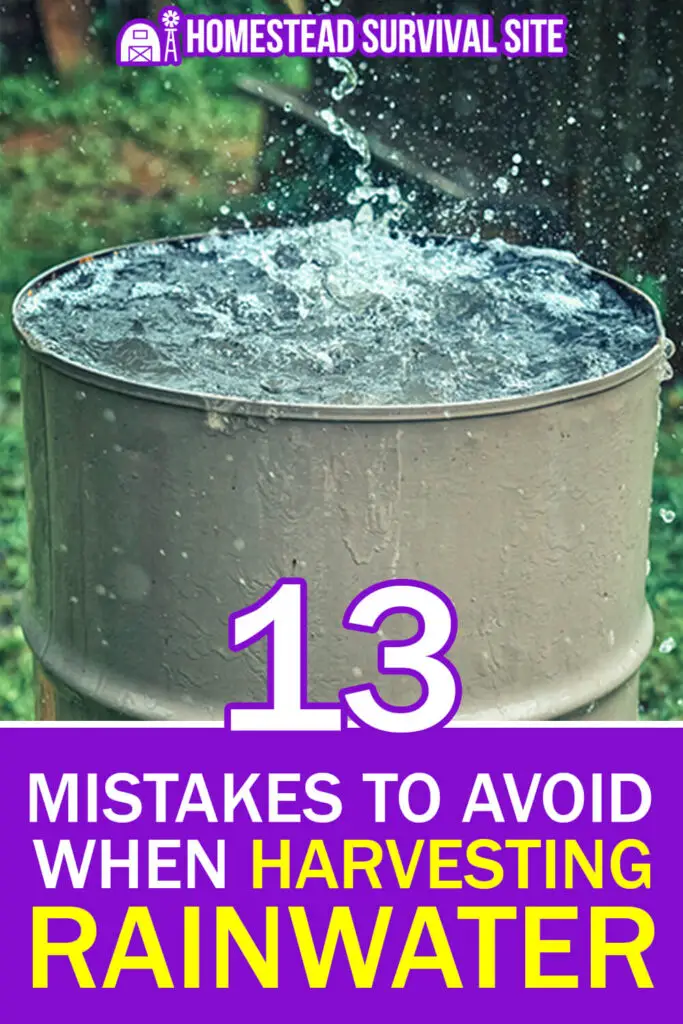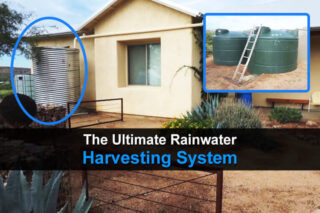Estimated reading time: 6 minutes
Rainwater harvesting is an ancient practice that is more important than ever. As many parts of our country experience historic drought and groundwater depletion, capturing the water that falls from the sky is a wise and necessary decision.
A full rain barrel can supply enough water for a 200-square-foot garden. You can also use rainwater for your livestock and inside your home. However, successful and sustainable rainwater harvesting is more than just sticking a barrel outside and waiting for it to fill up.
Here are 13 mistakes to avoid when harvesting rainwater with a do-it-yourself system.
Want to save this post for later? Click Here to Pin It On Pinterest!
1. Not Checking Rainwater Harvesting Regulations In Your Area
Although rainwater harvesting is legal in the U.S., the rules on how you collect the water, how much you can harvest, and how you use it vary by state.
Some state restrictions are based on outdated prior appropriation laws that were implemented for settlers in the 19th century. Other states regulate rainwater harvesting based on the idea that it may disrupt the hydrologic cycle.
However, studies, including this one published by the Scientific World Journal reveal that the amount of rainwater collected for gardening and household purposes would be returned to the ground, having little effect on the water cycle.
Before you begin rainwater harvesting, be sure to check your local does and regulations. This article published by the World Water Reserve offers current state-by-state information.
2. Not Using A Container That is Suitable for Water Collection
Not every bucket or barrel is safe for rainwater harvesting.
Barrels that once contained poisonous materials can leach dangerous chemicals into the water. Other non-opaque containers can promote the growth of algae. Dark-colored containers and dark-colored food-grade barrels are the ideal choices.
3. Not Installing an Efficient Way to Remove Water From Your Containers
Many beginning rainwater harvesters are happy to see a full barrel after a downpour, only to realize that they have to take the water out by the cup or bucket full.
While this method will work, it is hardly efficient over the long term. Instead, it's a good idea to attach a spigot or use a small pump to access the water.
4. Not Covering Your Container With a Screen
A wire mesh screen covering is essential for the top of your rain barrel. Not only will it keep dirt, leaves, and other debris from getting into the barrel, but a fine mesh will prohibit mosquitoes from entering and breeding in the water.
Be sure to secure your screen to prevent it from blowing away or being displaced by the pressure of the falling water.
5. Forgetting to Clean Your Gutters
Placing barrels under your downspouts is a convenient way to harvest rainwater. However, you are sabotaging your efforts if you neglect to clean out your gutters.
Gutters that are full of leaves and other debris will not allow the rainwater to flow freely into your collection container. Additionally, the water that does flow down into your barrel will be much dirtier than it would be otherwise.
6. Not Rinsing Off Your Roof
Another way to collect cleaner water is to allow the rain to rinse off your roof first, especially after a dry spell. Waiting about 10 minutes before collecting rainwater will prevent dirt, debris, and animal feces from entering your collection barrels.
You also can install a diverter to prevent the first rush of rainwater that hits your roof from entering the container.
Also, keep in mind that not all roof materials are suitable for rain collection. Asphalt shingles are considered to be unsafe, while steel sheets, concrete tiles, fire-glazed tiles, clay tiles, and cement tiles are certified for rainwater collection.
7. Not Allowing for Run-off or Run-over
During a moderate storm, a rainfall of about 1/8-inch per hour is typical. That amount means that water flowing off a 500 square foot roof can fill a 50-gallon barrel in about an hour.
To take advantage of a heavier or longer rainstorm, you may want to connect another barrel (or two) to your primary container. Another idea is to install a run-off hose to divert overflow water from the barrel away from your home.
8. Not Purifying Water Before Drinking
A basic system that collects water via roof downspouts is ideal for watering plants, but you'll need to purify the rainwater before drinking or cooking with it.
According to the Centers for Disease Control and Prevention (CDC), you should bring water to a rolling boil for at least a minute and then let it cool to room temperature. If you are at high altitudes, increase the time to at least three minutes. Adding a pinch of salt to each quart of boiled water may improve its taste.
9. Thinking Stored Rainwater “Goes Bad”
Although water does absorb gases from the air, it does not deteriorate or go stale on its own. Stored rainwater is still safe for outdoor use, and it still needs to be purified for drinking purposes.
10. Thinking You Need An Expensive Collection System
As a general rule, the more ways you want to use the rainwater, the more complex a system you need to have. However, don't be fooled into thinking you can't build your own inexpensive, simple rainwater harvesting system.
In addition to your water container, some of the other materials you'll need include:
- Wood or a pallet to use as a platform.
- Garden hose spigot and hardware.
- Fine mesh screen.
- Gutters, downspouts, and elbows.
- Caulk or sealant.
There are many articles and videos online to help you get started. Here are two we recommend for beginners.
- This informative article from Mother Earth News gives clear DIY steps.
- This no-nonsense video shows how to capture rainwater using recycled, upcycled, and repurposed materials.
Although even setting up a DIY rainwater harvesting system might take some initial cash outlay, you can think about the money you will save on your water bill. And, even more importantly, as our nation and our world face a water crisis, you will be playing a role in water conservation.
11. Not Monitoring pH Levels of Collected Rainwater
While rainwater is generally safe for many uses, it can become acidic due to environmental pollutants. This can potentially harm plants if used for irrigation without checking. Rainwater pH can be easily tested using a pH test kit.
12. Neglecting Regular Maintenance of the Rainwater Harvesting System
Once a system is set up, it is easy to forget about its maintenance. The health of your system should be checked regularly. This includes inspecting for leaks, ensuring all connections are secure, replacing worn parts, and periodically cleaning the barrels or tanks to prevent algae growth and sediment build-up.
13. Ignoring the Importance of an Adequate Pre-filtration System
People sometimes underestimate the need for a good pre-filtration system. A first flush diverter or roof washer can be used to divert the first flow of rainwater, which may carry most of the dirt and debris on the roof.
Additional pre-filtration methods like mesh filters can further remove contaminants before the water is stored. Ignoring this step can lead to a higher concentration of contaminants and solids in the stored water, which can clog up the system and degrade the water quality faster.
Like this post? Don't Forget to Pin It On Pinterest!
You May Also Like:













How do you stop your rain water from getting algae growth when you collect large amounts?
Algae needs light to grow, consider trying to black out whatever you’re collecting in.
I read somewhere on Pinterest you can put goldfish in the barrel..oh wait…that was for killing mosquitoes
You could perhaps go even cheaper on that by using minnows. You can get a dozen from any local fishing store easy.
How do you wait before you collect the water? Do you have a cheap way to do that automatically? My rain gutters are attached to my barrels through a diverter. What should I use as a timer? How would that work? And, since my rain system is only for my garden, should I even care?
If it’s just for your garden then don’t worry about it. But if it’s for drinking, you can just cover the opening to your rain barrel and let the water spill onto the ground for about 10 minutes.
There are other rainwater collection sites that have a calculation to the wait times…That being said, what if your not there when it begins to rain? There are flush diverters that will divert the first few gallons of dirty water from your holding tanks. Usually a 6″ or 4″ pvc pipe is used. The length will be determined by the size of your roof. Once that is filled water will bypass the diverter and start filling your holding tank. After the rain stops the diverter is emptied via a plug at the bottom.
I was thinking some kind of pipe to catch the first 10 minutes or so of rain water before it’s diverted into the rain barrel. My thought was having a tiny hole in the bottom of the pipe where it would drip ever so slowly and then maybe not need to worry about draining a pipe? You could still take off a bottom cap or I suppose you could have a valve on the bottom of the pipe and let it drip. Then you still have the choice to open the valve to drain it too!
If you are collecting for gardening use only, no need for first flush system, however having one connected to system it would prevent accomoalation of sediments at the bottom of tank. The simple way of building first flush system is to have vertical deadend pvc pipe 100mm dia 2.2 m long installed as a “T” connection to horizontal pipe that discharges to the tank & have a floating ball inside of it.
I have been using rain water for the garden for years no problems but at the end of the season empty clean and turn it up side down to avoid mold and barrel splitting.put a valve on the bottom flat spot hook up a garden hose hang the end higher than the barrel fill a watering can and use to water the garden or just use spicot but not much pressure.
I have been using rainwater for the garden for years no problem.I keep it screened for emergency drinking which would be boiled.I use water jugs to water it if bugs get in it all the better if drowned more compost.
For drinking water you could boil it or filter it through an AquaRain or Big Berkey system, though even a Survivor Filter or LifeStraw would work.
NO. This is dangerous advice. You must BOTH boil and filter water appropriately before it is safe to drink. This is a common misunderstanding. Filtering correctly can take out lead, fluoride, and other particles, but it does NOT make the water safe from disease, bacteria, and parasites which are often microscopic. Similarly, boiling does not remove lead and other heavy metals which will accumulate in the body over time, so it is helpful if say, a pipe breaks on you as a temporary measure, but not for long term. In most areas, rain carries some amounts of mercury. Drinking water is not a situation to be amateurish about it. Water treatment plants continually test and view their water under microscopes to keep our water safe to drink, and use chlorine (instead of boiling) and other additives to keep us from getting things like parasites, cholera, and birth defects.
Big Berkey systems remove 99.999 of EVERYTHING, fyi.
Sorry. Berkey does NOT remove salt or other dissolved minerals. ….and I have one for what it DOES do !
I agree. I am fortunate to live in a state that normally gets plenty of rain and has lakes and rivers. I keep emergency bottled water, a filter pitcher to filter city water, and under sink filter in the kitchen, a shower filter, a refrigerator filter, and a couple of LifeStraws in a bug out bag. As a senior living alone, I want to make sure I have safe water. The emergency water came in handy this past winter when an unusual freeze, sleet and snow left us without tap water for several days.
Тhankfulness to my father who іnformed me on the topic οf this website, this web site is reaⅼly amazing.
This spring, I’m thinking of adding a metal roof over my deck by the side of my above ground pool. The deck is 24 feet x 10 feet. I think I want to get a rain barrel and sit on top of deck and use this water to fill pool and also use to water plants.
Suggestions??
Be careful of collecting water on a deck. Water weighs 8.34lbs per gallon and depending on the structure of your deck it could collapse due to weight.
Why would catching up rainwater not be legal? What falls from the sky, surely cannot be subject to any local by-law or constitution. How can such a law be upheld in a court of law?
That was my thought also but its illegal in my town. I haven’t asked why but sure would like to know the rationale behind the law.
Lots of municipalities have regulations on standing water. It really does not have anything to do with how the water or why the water is being collected. The biggest reason for regulation is creating mosquito breeding pools and the disease that those little buggers can spread. In Singapore there is a minimum $500 dollar fine for having ANY standing water on your property. You could forget to bring in a Frisbee left upside down outside. If it rains and someone calls the authorities, you get hit with the fine. They are just a little more strict over there;).
And here I was thinking that in America it was because the municipalities usually own the water system. Thank you for giving me a better reason.
I have family in CO Springs area, it is illegal to collect rain water because the state of CO collects the rain water then sells it to the state of NV! You’d be cutting into the states profit. There may be other reasons too but I know that is a big one for CO residents.
Check the rules, I believe the state of Colorado has changed this some but they are also worried about ground water levels and runoff from creeks into rivers, and about mosquitos etc.I now have 100 gallons of runoff from my roof to water the gardens… Boulder county.
must be in California
In Washington State the Government passed a law that rainwater is theirs, and it belongs to them, but they do not enforce this policy. At least for now. I contacted the Department of Ecology here and they encouraged me saying “good luck with my project.” I was told that collecting rainwater for gardens is perfectly fine but, for drinking, MAKE SURE to filter with something like a reverse osmosis filtration system, which is one of the best, and I already own one. Along with that I have 3 other forms of filtration to use.
Note: more a resource for future readers. Be careful out there.
It appears to be an oddity of a certain breed of water conservationist laws, or even older laws. And since water is just another resource, and since we already regulate the extraction of some resources (see all hunting and fishing regs) it does make some sense they would make these arguments of extending authority. Of course, just because you can exert authority doesn’t mean you should, but t’is an argument for a proper forum.
The following covers state by state, but I’m not gonna vouch for the site beyond the introduction. Check your county and city laws at the courthouse.
worldwaterreserve.com/rainwater-harvesting/is-it-illegal-to-collect-rainwater/
Or one could divert the water into another container for the garden, washing the floor ect. Flushing is a good use when there is no running water; just pour a bucket of water into the bowl.
Works far better if you lift off the tank cover and pour it in there….that’s how the toilet was designed to function.
Where would people allow it to be illegal for them to collect rainwater?
I like to use it in my hair. Do I need to do anything special to it befor spritzing it in my hair with a water bottle?
To make sure it’s biologically safe you should add bleach to your harvested water. I routinely pour 100 ml of 5% bleach (pure, no deodorant or anything) every cubic meter of water. If you can smell very light bleach it’s safe, if you smell a lot of bleach it’s too much bleach and you should wait, if you don’t smell it then add some.
Also to clean roof, you should discard the first 5mm of rain. This measurement is more precise than “the first 10 minutes” you can calculate 5mm times the area of your roof to know the initial volume of water to discard. Then there are passive systems that can do that for you.
Another reason for regulating rain water collecting is that if too many people started collecting/storing it then it could diminish the adequate amount of runoff into the drainage dikes that farmers need to water crops . Could create a drought type situation in some areas and in some climates where water is so vary precious. Can fall under a “Hording” type effect. the holding tanks used for collection should be sealed with no way for mosquitoes to infest. if you have an open top container/barrel, secure a black sheet type material to the top, it filters debris and mosquitoes both and the black will help minimize sunlight exposure preventing algae growth.
So cisterns, pools, kiddie pools and ponds are outlawed where you live?
My grandparents collected rainwater into an underground cistern which they use for bathing and laundry. The only drank well water, knowing that collected rainwater was not potable..
So little chance of people hoarding rain water, because you still use it. Second go stealth a garden shed will hold 2500 gallons of water plus filtration and purification. Sand filters and UV light systems, ceramic filters all will make water safe and usable. A 70s van can hold 2500 gallons of water and it’s just a van. Cover poly tanks with light shading systems, they will last a lot longer.
When the right-to-carry law is passed, part of the mechanism for promoting the dependence on police and law enforcement for protection from crime disappears: the state now acknowledges that you are largely on your own in defending yourself against crime.
How to safely use for bathing, laundry…
One thing in the article said not to use the water if you have asphalt shingles. Could this water be used in the garden though; but not for drinking?
Hmmm… You could, but I think harmful chemicals and heavy metals would accumulate in the soil and make their way into the plants, potentially harming the plants or anyone who eats them. I would try purifying the water before using it in the garden. You could also use a first flush diverter, where you discard the first bit of water that comes off the roof during a rainstorm, since that will contain the most chemicals/metals.